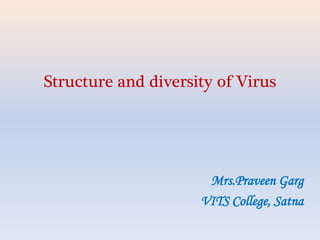
Structure and diversity of virus
- 1. Structure and diversity of Virus Mrs.Praveen Garg VITS College, Satna
- 2. Introduction • A virus is made up of a DNA or RNA genome inside a protein shell called a capsid. • Some viruses have an external membrane envelope. • Viruses are very diverse. • They come in different shapes and structures, have different kinds of genomes, and infect different hosts. • RNA or DNA act as genetic material. • The nucleic acid may be single- or double-stranded. • The entire infectious virus particle, called a virion, consists of the nucleic acid and an outer shell of protein.
- 3. • The simplest viruses contain only enough RNA or DNA to encode for proteins. • Viruses is the link between living and non living. • Viruses are not considered living because they can't reproduce by themselves (without a host). • Viruses have no cells, it is just packages of nucleic acid and protein. • A virus is a submicroscopic infectious agent that replicates only inside the living cells of an organism. • Viruses infect all types of life forms, from animals and plants to microorganisms, including bacteria and archaea.
- 4. History • Dutch microbiologist Martinus W. Beijerinck, who coined the term "virus“. • Beijerinck is often called the Father of Virology. • In 1892, Dmitri Ivanovsky discovered the virus firstly in tobacco plant. • Tobacco Mosaic Virus is the first virus discovered by Ivanovsky.
- 5. Characters of Virus • They can mutate. • They are acellular, that is, they contain no cytoplasm or cellular organelles. • They carry out no metabolism on their own and must replicate using the host cell's metabolic machinery. • In other words, viruses don't grow and divide without host. • The vast majority of viruses possess either DNA or RNA but not both.
- 6. • All viruses contain the following two components: A nucleic acid genome or viral core A protein capsid that covers the genome. This is called the nucleocapsid. • Sometime third component also present. Lipid and polysaccharide envelope. Structure of Virus
- 8. Viral core: It is the nucleic acid component, which makes up the genome of the virus. The viral core provides genetic information that determines pathogenicity, antigenicity, proliferation, heredity, variation, etc. The chemical components of the viral core are DNA or RNA, based on whether the virus is classified as a DNA virus or an RNA virus. Nucleic acid can be single or double stranded.
- 9. Viral capsid: It is a protein shell that surrounds and protects the nucleic acid from digestion by enzymes. It contains special sites on its surface that allow the virion attach to a host cells. One of the viral structural proteins (either an envelope glycoprotein for the enveloped viruses or a capsid protein for the nonenveloped viruses) directly binds to the cellular receptor, for the viral entry. The viral capsid is composed of repeated protein subunits known as capsomere. It enable the virion to penetrate the host cell membrane and, in some cases, to inject the infectious nucleic acid particles.
- 10. Envelope: • Envelope is the one or two layers of membrane that surround the capsid of some viruses. • The envelope is formed during the maturation process when certain viruses bud out from the cell membrane. • Therefore, the envelope can be composed of the host cell membrane and/or the nuclear membrane. • The surface of some viral envelopes carries protein protrusions called peplomers or spikes.
- 11. Classification Viruses are classified into four groups based on shape: Filamentous, Isometric (or icosahedral), Enveloped, and Head and tail. • Many viruses attach to their host cells to facilitate penetration of the cell membrane, allowing their replication inside the cell.
- 12. The diversity of Viruses • Viruses show great diversity in their genome structure and replication mode. • Viruses have been found that attack animal cells, plant cells, and bacterial cells. • Different viruses have from three to just over 2500 genes. • Many viruses replicate their genomes by some form of rolling circle mechanism with the RNA replicase enzyme. • Virus particles come in a wide range of sizes and shapes. • Bacteriophage is a common virus have an larger genome. • Bacteriophage ΦX174 is a small simple spherical virus that contains 5386 bases of circular single-stranded DNA. • Bacteriophage M13 is a filamentous shape. It has single- stranded circular DNA.
- 13. • Complex Bacterial Viruses With Double-Stranded DNA that infects B. megaterium. • There is a large family of bacterial viruses that all have a complex form made up of a head, tail, and tail fibers. • This group includes some of the most complex known viruses. • The head of the virus particle contains a large molecule of linear double-stranded DNA. • They include bacteriophages T4, Lambda, P1, and Mu, which are all used in bacterial genetics.
- 15. Thank You